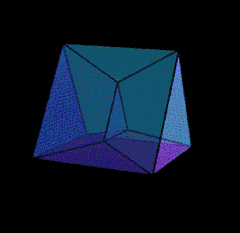In the geometry of 4 dimensions, the 3-3 duoprism or triangular duoprism is a four-dimensional convex polytope.
| 3-3 duoprism | |
|---|---|
 3D perspective projection with two different rotations | |
| Type | Uniform duoprism |
| Schläfli symbol | {3}×{3} = {3}2 |
| Coxeter diagram | |
| Properties | convex, vertex-uniform, facet-transitive |
Descriptions
editThe duoprism is a 4-polytope that can be constructed using Cartesian product of two polygons.[1] In the case of 3-3 duoprism is the simplest among them, and it can be constructed using Cartesian product of two triangles. The resulting duoprism has 9 vertices, 18 edges,[2] and 15 faces—which include 9 squares and 6 triangles. Its cell has 6 triangular prism. It has Coxeter diagram , and symmetry [[3,2,3]], order 72.
The hypervolume of a uniform 3-3 duoprism with edge length is This is the square of the area of an equilateral triangle,
The 3-3 duoprism can be represented as a graph with the same number of vertices and edges. Like the Berlekamp–van Lint–Seidel graph and the unknown solution to Conway's 99-graph problem, every edge is part of a unique triangle and every non-adjacent pair of vertices is the diagonal of a unique square. It is a toroidal graph, a locally linear graph, a strongly regular graph with parameters (9,4,1,2), the rook's graph, and the Paley graph of order 9.[3][4] This graph is also the Cayley graph of the group with generating set .
The minimal distance graph of a 3-3 duoprism may be ascertained by the Cartesian product of graphs between two identical both complete graphs .[5]
3-3 duopyramid
editThe dual polyhedron of a 3-3 duoprism is called a 3-3 duopyramid or triangular duopyramid.[6], page 45: "The dual of a p,q-duoprism is called a p,q-duopyramid."</ref> It has 9 tetragonal disphenoid cells, 18 triangular faces, 15 edges, and 6 vertices. It can be seen in orthogonal projection as a 6-gon circle of vertices, and edges connecting all pairs, just like a 5-simplex seen in projection.
The regular complex polygon 2{4}3, also 3{ }+3{ } has 6 vertices in with a real representation in matching the same vertex arrangement of the 3-3 duopyramid. It has 9 2-edges corresponding to the connecting edges of the 3-3 duopyramid, while the 6 edges connecting the two triangles are not included. It can be seen in a hexagonal projection with 3 sets of colored edges. This arrangement of vertices and edges makes a complete bipartite graph with each vertex from one triangle is connected to every vertex on the other. It is also called a Thomsen graph or 4-cage.[7]
See also
edit- 3-4 duoprism
- Tesseract (4-4 duoprism)
- Duocylinder
References
edit- ^ Coxeter, H. S. M. (1948), Regular Polytopes, Methuen & Co. Ltd. London, p. 124
- ^ Li, Ruiming; Yao, Yan-An (2016), "Eversible duoprism mechanism", Frontiers of Mechanical Engineering, 11: 159–169, doi:10.1007/s11465-016-0398-6
- ^ Fronček, Dalibor (1989), "Locally linear graphs", Mathematica Slovaca, 39 (1): 3–6, hdl:10338.dmlcz/136481, MR 1016323
- ^ Makhnev, A. A.; Minakova, I. M. (January 2004), "On automorphisms of strongly regular graphs with parameters , ", Discrete Mathematics and Applications, 14 (2), doi:10.1515/156939204872374, MR 2069991, S2CID 118034273
- ^ Chen, Hao (2016), "Apollonian Ball Packings and Stacked Polytopes", Discrete & Computational Geometry, 55 (4): 801–826, doi:10.1007/s00454-016-9777-3
- ^ Mattheo, Nicholas (2015), Convex polytopes and tilings with few flag orbits, Boston, Massachusetts : Northeastern University, doi:10.17760/D20194063
- ^ Coxeter, H. S. M. (1974), Regular Complex Polytopes, Cambridge University Press, p. 110, 114
- Coxeter, The Beauty of Geometry: Twelve Essays, Dover Publications, 1999, ISBN 0-486-40919-8 (Chapter 5: Regular Skew Polyhedra in three and four dimensions and their topological analogues)
- Coxeter, H. S. M. Regular Skew Polyhedra in Three and Four Dimensions. Proc. London Math. Soc. 43, 33-62, 1937.
- John H. Conway, Heidi Burgiel, Chaim Goodman-Strauss, The Symmetries of Things 2008, ISBN 978-1-56881-220-5 (Chapter 26)
- Norman Johnson Uniform Polytopes, Manuscript (1991)
- N.W. Johnson: The Theory of Uniform Polytopes and Honeycombs, Ph.D. Dissertation, University of Toronto, 1966
- Catalogue of Convex Polychora, section 6, George Olshevsky.
External links
edit- The Fourth Dimension Simply Explained—describes duoprisms as "double prisms" and duocylinders as "double cylinders"
- Polygloss – glossary of higher-dimensional terms
- Exploring Hyperspace with the Geometric Product